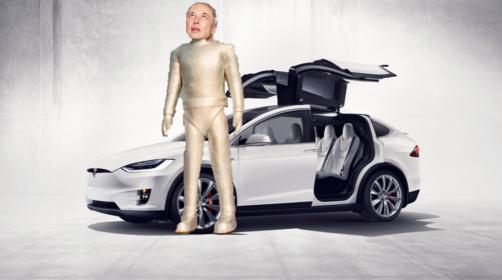 Tesla Motors held an investor event at its Palo Alto headquarters. CEO Elon Musk and a series of Tesla executives announced a new in-house developed microprocessor (already in production and being deployed in Tesla vehicles) and its plans and progress toward autonomous vehicle operation.
Tesla Motors held an investor event at its Palo Alto headquarters. CEO Elon Musk and a series of Tesla executives announced a new in-house developed microprocessor (already in production and being deployed in Tesla vehicles) and its plans and progress toward autonomous vehicle operation.
Tesla Autonomy Day Live Stream
To be clear – all Tesla vehicles are now getting the new processor the performance of which will be defined by software delivered via over-the-air updates. It’s a minor point for Tesla, which has been doing software updates for years. It’s a monumental change in business practices for the industry.
Musk and his colleagues held forth from a stage in front of an audience of rapt analysts and investors whose silence reflected the collective inhale being experienced across the entire automotive industry and supply chain. Musk’s announcement marked yet another key turning point for the company. He said Tesla is now focused completely on enabling automated driving with the objective of launching a fleet of robotaxis by the end of 2020.
The new microprocessor was the focal point of the event. Musk and his lead designer noted multiple performance advantages over the existing Nvidia hardware in use in older Tesla vehicles. (Nvidia released a blog today challenging and correcting some of Tesla’s claims.)
The event was preceded by Easter weekend news of a Tesla Model S bursting into flames in a parking garage in China and rumors of declining vehicle shipments in advance of Wednesday’s earnings report. Unfazed, Musk took the occasion to cast some shade on erstwhile supplier Nvidia while pointing out what he described as “the fool’s errand” of trying to use lidar technology to enable automated driving.
Despite the fact that so many organizations large and small are working on self-driving car technology, Musk has emerged from the autonomous driving mosh pit as a thought leader matched only in media-attention-getting magnitude by Amnon Shashua of Mobileye. Interestingly, both Shashua and Musk share the same vision of camera-centric automated driving enhanced with ultrasonic and forward facing radar sensors.
There are other contenders for the thought leadership throne in automated driving including Kyle Vogt at Cruise Automation, Jensen Huang of Nvidia, Gil Pratt at Toyota Research Institute, George Hotz formerly of Comm.ai, and Sebastian Thrun and Anthony Levandowski formerly of Google. But only Musk can stop the automotive industry in its tracks with his pronouncements regarding the future of autonomy commanding, as he does, a fleet of hundreds of thousands of connected vehicles.
Musk is the ultimate disruptor – if not outright shredder – of the automotive industry. His investments in electrification are an existential threat to 50% of the industry’s existing internal combustion-centric supply chain.
A Tesla’s engine is its microprocessor and Musk made clear his intention to use that engine in combination with crowd sourced data to refine the software necessary to go with the new chip to enable automated driving. Musk’s core message from the event was that the new chip is capable of enabling full automation, once the software is refined and deployed.
The key takeaways from yesterday’s event included:
- Lidar is a dead-end, waste of time for autonomous vehicle development
- High definition maps are unnecessary to enabling automated driving
- The software code in the new processors are cryptographically signed meaning they can only run Tesla-approved/signed code
- The new processors are already being built into Model S, X, Y, and 3 vehicles
- Work on the next generation processor is already well under way, a couple years from completion and will offer a 3X performance gain
Post-event, a bruised Nvidia was quick to note in a blog that its own AI computing hardware offers competitive performance and is “available for the industry to build on” – unlike Tesla’s.
Musk’s pronouncements detonate in the midst of an autonomous vehicle development environment coming to grips with deferred expectations. The growing recognition of the enormity of the technical challenge appears to have caused many market participants to reconsider their public comments or their inclination to say anything at all about their methodology or strategy.
In this environment, Musk’s voice remains loud, clear and unwavering – and automotive executives know they can’t afford not to listen. We may not know for quite some time whether Musk is right on all points. But alone, among many contenders, he is outspoken about his own strategy and opinionated regarding paths – or the path – to autonomy.
Musk, like his competitors, is facing a major leap of faith and technical achievement to deliver fully automated driving. But he must face the fact that lives have been lost in his pursuit of autonomy and skeptics remain.
Only one thing is clear. Musk stands alone in the global industry with the greatest trove of automated and non-automated driving data. At the event he even went so far as to question the efficacy of using simulation software as an alternative to the data collected from human driven miles.
So Musk would and will do without lidar, high definition maps, nvidia, and simulation in his autonomous quest. It remains to be seen how tolerant consumers, investors and regulators will remain should fatalities or flaming cars continue to manifest. Musk remains focused and affirmative – unfortunately he is also fallible. We can only hope no more lives will be lost to Musk’s margin of error.
Share this post via:





Quantum Computing Technologies and Challenges